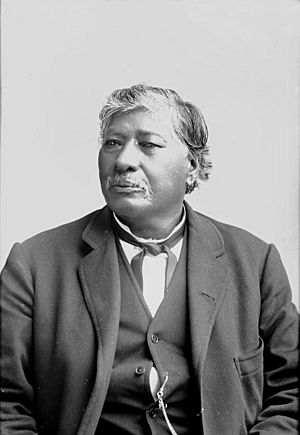John Jumper (Seminole chief) facts for kids
Quick facts for kids
Colonel
John Jumper (Heneha Mekko)
|
|
|---|---|

John Jumper's Indian name was Heneha Mekko or "Assistant Chief"
|
|
| Birth name | Unknown |
| Born | c. 1820 Florida |
| Died | September 21, 1896 Sasakwa, Indian Territory |
| Allegiance | |
| Service/ |
|
| Rank | Colonel |
| Unit | 1st Seminole Battalion and 1st Seminole Regiment |
John Jumper (born around 1820 – died September 21, 1896) was an important leader of the Seminole Nation. His Seminole name was Heneha Mekko, which means "Assistant Chief." He served as the Principal Chief of the Seminole Nation twice: from 1849 to 1865, and again from 1882 to 1885. John Jumper was also a Baptist pastor.
During the American Civil War, Jumper led the Seminole people who chose to support the Confederacy. He signed a treaty with the Confederate government, hoping that the Seminoles might get their own state if the Confederacy won. He also served as a lieutenant colonel in the Confederate Army with the Seminole Mounted Volunteers.
Becoming a Leader
John Jumper was born in Florida into a well-known Seminole family. His uncle was Micanopy, who was a very important chief of the Seminole tribe. His father, Ote Emathla, was also a respected Seminole leader and an advisor to Micanopy.
Jumper fought against the United States in the Second Seminole War (1835-1842). After being captured, he was moved to what was then called Indian Territory.
In 1849, John Jumper became the Principal Chief of the Seminoles after his brother, James Jumper, passed away. As chief, he helped create the Seminole Nation in Indian Territory in 1856. He also supported setting up schools for his people, with help from Presbyterian ministers. In 1850, he even traveled back to Florida to encourage other Seminoles to join them in Indian Territory.
Role in the Civil War
When the American Civil War began, Chief Jumper decided to sign an agreement with the Confederate States of America. He also joined the Confederate Army.
He first served as a major in the First Battalion Seminole Mounted Rifles. Later, he became a lieutenant colonel in the First Regiment Seminole Volunteers. He led these troops in several battles, including Round Mountain, Chusto-Talasah, Middle Boggy, and Second Cabin Creek.
Life After the War
After the Civil War ended, John Jumper became an ordained Baptist minister in 1865. He served as the pastor of Spring Baptist Church near Sasakwa in the Seminole Nation, Indian Territory. He continued as pastor there until 1894.
Because the Seminoles had sided with the Confederacy, the United States government made them sign a new peace treaty after the war. This treaty required the Seminoles to free their enslaved people. It also said that any freedmen who wanted to stay in Indian Territory could become full citizens of the Seminole tribe.
John Jumper represented the Southern Seminoles at the Fort Smith Council in 1865. At this meeting, the U.S. Government recognized John Chupko, who had supported the Union, as the Principal Chief of the Seminole Nation.
Later, John Jumper was elected Principal Chief again in 1882. He served until 1885, when his son-in-law, John F. Brown, took over the role.
Death
John Jumper passed away at his home near Wewoka, Indian Territory, on September 21, 1896.

